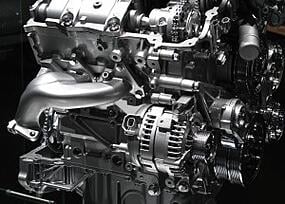Engine and Power Train Testing Applications
Pressure is a big part of engine testing and automotive component manufacturing. That’s why wherever you find engines being tested; you’ll likely find transducers measuring everything from air intake pressures to exhaust back-pressures. In the automotive industry, you’ll find transducers measuring everything from tire inflation pressure for dynamometer testing to controlling tool pressure during crankshaft journal burnishing.
See below for the different applications of where test & measurement transducers are used and why:
Intake Manifold
The primary function of the intake manifold is to evenly distribute the combustion mixture (or just air in a direct injection engine) to each intake port in the cylinder head(s). Even distribution is important to optimize the efficiency and performance of the engine. It may also serve as a mount for the carburetor, throttle body, fuel injectors and other components of the engine.
Exhaust Manifold
Exhaust manifolds are generally simple cast iron or stainless steel units which collect engine exhaust from multiple cylinders and deliver it to the exhaust pipe. (1 to 10 PSI)
Exhaust Gas Recirculation (EGR)
EGR works by recirculating a portion of an engine's exhaust gas back to the engine cylinders. In a gasoline engine, this inert exhaust displaces the amount of combustible matter in the cylinder. This means the heat of combustion is less, and the combustion generates the same pressure against the piston at a lower temperature. In a diesel engine, the exhaust gas replaces some of the excess oxygen in the pre-combustion mixture.
Exhaust Back Pressure
A slight pressure in the exhaust system is normal. However, excessive exhaust back pressure seriously affects engine operation. It may cause an increase in the air box pressure with a resultant loss in the efficiency of the blower. This means less air for scavenging, which results in poor combustion and higher temperatures. (Measured in inches of mercury – can range from 3.8 to 33.5“ Mercury.)
Crankcase pressure
The crankcase pressure indicates the amount of air passing between the oil control rings and the cylinder liner into the crankcase, most of which is clean air from the air box. A slight pressure in the crankcase is desirable to prevent the entrance of dust. A loss of engine lubricating oil through the breather tube, crankcase ventilator or dipstick hole in the cylinder block is indicative of excessive crankcase pressure. (Measured in inches of H2O – usually 0.5 to 1” W.C.)
Engine Control
For engine control applications, advanced electronic control systems for turbocharged gasoline and diesel truck engines. Can measure fuel, oil, exhaust and turbo boost pressures. Barometric and differential pressure transducers are used to determine mass airflow.
Gas Turbines
Pressure data for gas turbine engines, aircraft auxiliary power engines, and automotive engines can be obtained.
Diesel Engines
Performance analysis of the various diesel engine parts can be conducted. With transducers, horsepower, fuel consumption and turbo efficiency, coolant lubrication, and fuel system operation can be determined.
Engine Pressure Ratio (EPR) Measurement
This measurement includes the core engine exhaust pressure compared to the intake pressure to the gas turbine engine.
Other Automotive Testing Applications:
- Verify turbo-jet and turbo-fan aircraft engines meet certification standards
- Engine oil and coolant pressures ( 100 PSI+)
- Fuel line pressure (100 PSI+, depending on turbo)
- Fuel system pressurization and flow
- Inlet and exhaust pressures
- Barometric pressure (measured in inches of Mercury)
CLICK HERE to discover more about pressure transducers for test and measurement applications.



